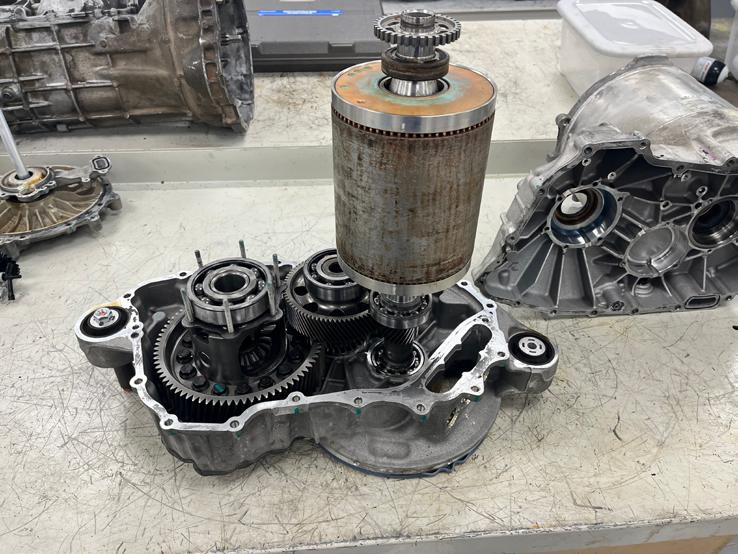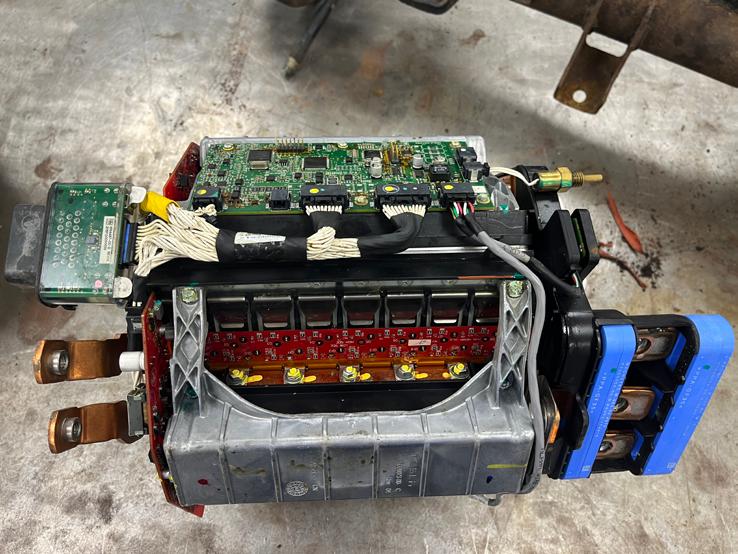
5 minute read
April 2024 Hybrid & Electric Vehicle Corner
by NACATNews
By Curt Ward, Professor at Joliet Junior College
Exploring a Tesla Inductive Drive Motor
As I write this article, warm weather has arrived in Chicagoland, and the spring semester is fast coming to a close. Recently, our program had the opportunity to acquire a used rear drive motor assembly from a 2015 Tesla Model S. The main reason for adding this drive motor to the class is that it is an induction style motor. This drive motor contrasts with other permanent magnet style drive motors we already have in our program. The unit has been disassembled and a power flow demonstrator has been created. In this article we will share some of what we learned during the disassembly.
The drive motor is from a standard range, rear wheel drive Model S (See Figure 1 - drive motor assembly). The drive unit contains the drive motor and the inverter. DC voltage is delivered from the battery, and the inverter changes the DC volts to AC volts to operate the drive motor. The mechanical portion of the drive unit is lubricated with automatic transmission fluid and coolant is circulated throughout the unit to remove the heat from the inverter, the electric motor and the transmission fluid used to lubricate the mechanical components. The oil pump is a mechanical unit driven by the ring gear (See Figure 2 – oil pump assembly). Anytime the wheels are turning, lubrication is provided for the mechanical portion of the drive unit. We discovered during the disassembly process that a failed coolant passage seal allowed coolant to fill the normally dry electric motor cavity, likely causing a loss of isolation failure, and caused damage to the front armature support bearing (See Figure 3 – failed seal). Later, we learned this is a relatively common failure in this generation of drive motor assemblies.



The induction style drive motor uses a copper core armature instead of permanent magnets. It is a 3-phase, 4-pole design. The connector bars appear to go straight through the armature instead of being a twisted design. On the front end of the armature is a speed sensor reluctor wheel. The armature is monitored by a dual hall effect sensor for speed only. An induction style motor does not require monitoring for position or direction of rotation like a permanent magnet style armature and therefore does not require the use of a resolver. The armature is supported by two sealed bearings that have non-conductive balls made of silicon nitride. This design improves the bearings durability and gives it an insulating property.
The power flow demonstrator is relatively simple in design (See Figure 4 – power flow demonstrator). The electric motor output gear drives an intermediate gear. The intermediate gear also serves as the pinion gear and turns the differential that provides the power to the drive wheels via the half-shafts. It takes just under 9.75 turns of the electric motor to turn the differential once. Our students will be able to use the power flow demonstrator to identify the components, describe the power flow, and calculate the gear reduction.

The inverter contains the low voltage control circuits as well as the transistors (IGBTs) to control the voltage and current needed to operate the drive motor (See Figure 5 – Inverter).

After searching the Tesla online parts catalog, we determined that Tesla is not servicing any of the internal components in this unit. It appears that any internal failure, mechanical or electrical, will result in a unit replacement. An Internet search revealed that some aftermarket service facilities are replacing the failed seal and bearing discussed earlier in the article.
Would you like to know more? Look out for my presentation at this summer’s NACAT conference titled: Tesla Update & Adding Tesla to our Hybrid and Electric Vehicle Classroom. In this class will explore many Tesla related topics, including the induction style drive motor assembly.
I will finish this article with the same offer I make after each of my presentations. If you are interested in getting started in the process of adding hybrid and electric vehicles to your curricuulum or want more information, please feel free to reach out. I am more than willing to sit down in-person or online and share my experiences. Are you looking for a classroom textbook? Reach out to Pearson and ask for a review copy of the all-new Electric and Hybrid Electric Vehicle text that Jim Halderman and I co-authored. It is a comprehensive text covering all the latest information on the subject.



